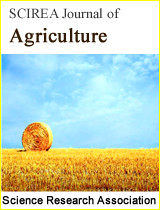Isolation, Identification and Taxonomic affiliation of Exopolysaccharide Producing lactic acid bacteria from Kradi cheese
DOI: 10.54647/agriculture21247 99 Downloads 161737 Views
Author(s)
Abstract
Kradi cheese is manufactured by coagulation of naturally fermented butter milk containing different strains of lactic acid bacteria. In this study lactic acid bacterial strains were isolated from kradi cheese and screened for exopolysaccharide potential. The taxonomic group of the exopolysaccharide producing lactic acid bacterial strains was determined on the basis of their 16S rRNA sequences. Nine strains were shown to produce exopolysaccharides in MRS medium with sucrose. Four strains belonged to lactococcus lactis subsp. lactis and five strains to Lactococcus lactis subsp. cremoris species. Isolated strains showed varied yield of exopolysaccharides. The exopolysaccharides had high molecular mass of 1500 kDa and glucose was dominant in their monomer composition.
Keywords
lactic acid bacteria, isolation, taxonomic affiliation, exopolysaccharides, monomer composition
Cite this paper
Hilal Ahmad Punoo,
Isolation, Identification and Taxonomic affiliation of Exopolysaccharide Producing lactic acid bacteria from Kradi cheese
, SCIREA Journal of Agriculture.
Volume 6, Issue 6, December 2021 | PP. 91-98.
10.54647/agriculture21247
References
| [ 1 ] | Deepak V, Ram Kumar Pandian S, Sivasubramaniam S D, Nellaiah H & Sundar K (2016a). Optimization of anticancer exopolysaccharide production from probioticLactobacillus acidophilus by response surface methodology. Preparative Biochemistry and Biotechnology 46(3) 288–297. |
| [ 2 ] | Deepak V, Ramachandran S, Balahmar R M, Pandian S R K, Sivasubramaniam S D, Nellaiah, H & Sundar K (2016b). In vitro evaluation of anticancer properties ofexopolysaccharides from Lactobacillus acidophilus in colon cancer cell lines. In VitroCellular & Developmental Biology – Animal 52(2) 163–173. |
| [ 3 ] | Bernal P & Llamas M A (2012). Promising biotechnological applications of antibiofilm exopolysaccharides. Microbial Biotechnology 5(6) 670–673. |
| [ 4 ] | Punoo H A, Patil GR, Singh RRB. (2018a) Textural and microstructural properties of Kradi cheese (an indigenous cheese of Jammu and Kashmir, India). International Journal of Dairy Technology, 71, 2,372-381 . |
| [ 5 ] | Punoo HA, Patil GR, Singh RRB (2018b) Physico-chemical and microbiological composition of Kradi cheese. Indian Journal of Dairy Science, 71 (2), 152-155 |
| [ 6 ] | Ruas-Madiedo P, Hugenholtz J & Zoon P (2002). An overview of the functionality of exopolysaccharides produced by lactic acid bacteria. International Dairy Journal 12(2–3) 163–171. |
| [ 7 ] | Abedfar A & Hossininezhad M (2016). Overview of the most important characterization of exopolysaccharides produced by probiotics bacteria and their biologicalfunction. Journal of Environmental Science, Toxicology and Food Technology10 47–55. |
| [ 8 ] | Patel S, Majumder A & Goyal A (2012). Potentials of exopolysaccharides from lactic acid bacteria. Indian Journal of Microbiology 52(1) 3–12. |
| [ 9 ] | Ciszek-Lenda M (2011). Biological functions of exopolysaccharides from probiotic bacteria. Central European Journal of Immunology 36 51–55. |
| [ 10 ] | Grosu-Tudor S S & Zamfir M (2013). Functional properties of lactic acid bacteria isolated from Romanian fermented vegetables. Food Biotechnology 27 235 – 248. |
| [ 11 ] | Van DerMeulen R, Grosu-Tudor SS, Mozzi F, Vaningelgem F, Zamfir M, DeValdez G F & DeVuys L (2007). Screening of lactic acid bacteria isolates from dairy and cereal products forexopolysaccharide production and genes involved. Int. J. Food Microbiol.118 250 – 258. |
| [ 12 ] | Grosu-Tudor S S, Zamfir, Van DerMeulenR & DeVuysL (2013). Isolation of novel homopolysaccharide producing lactic acid bacteria from Romanian raw milk and fermented dairyproducts. Eur. Food Res. Technol. 237 609 – 615. |
| [ 13 ] | De Man, J.C., Rogosa, M., & Sharpe, M.E. (2013). A medium for the cultivation of lactobacilli. J. Appl.Bacteriol.23 130 – 135(2013). |
| [ 14 ] | DeVusy L, Vanderveken F, Van DerVenS & Degees B (1998). Production by and isolation ofexopolysaccharides from Streptococcus thermophilus grown in a milk medium and evidence for theirgrowth-associated biosynthesis. J. Appl. Microbiol.84 1059 – 1068. |
| [ 15 ] | Wall P E (2005). Thin layer chromatography. A modern practical approach.The Royal Society of ChemistryThomas Graham House Cambridge, UK. |
| [ 16 ] | Ullrich M (2009). Bacterial polysaccharides. Current innovation and future trends. Jacobs University Bremen,28759 Bremen, Germany. |

